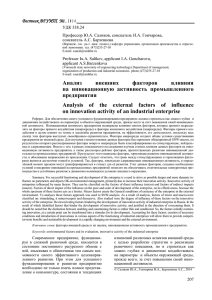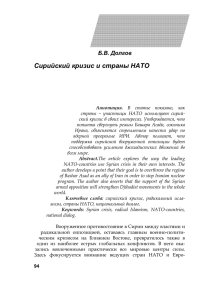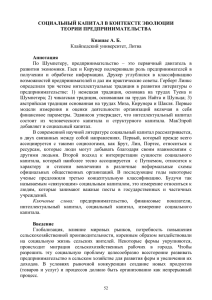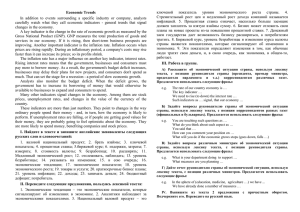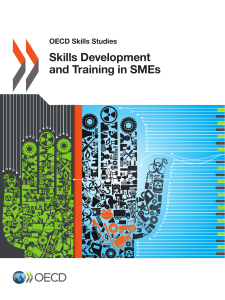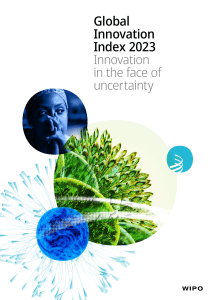3.2. МИРОВЫЕ ТРЕНДЫ В РАЗВИТИИ ИННОВАЦИОННОГО
реклама
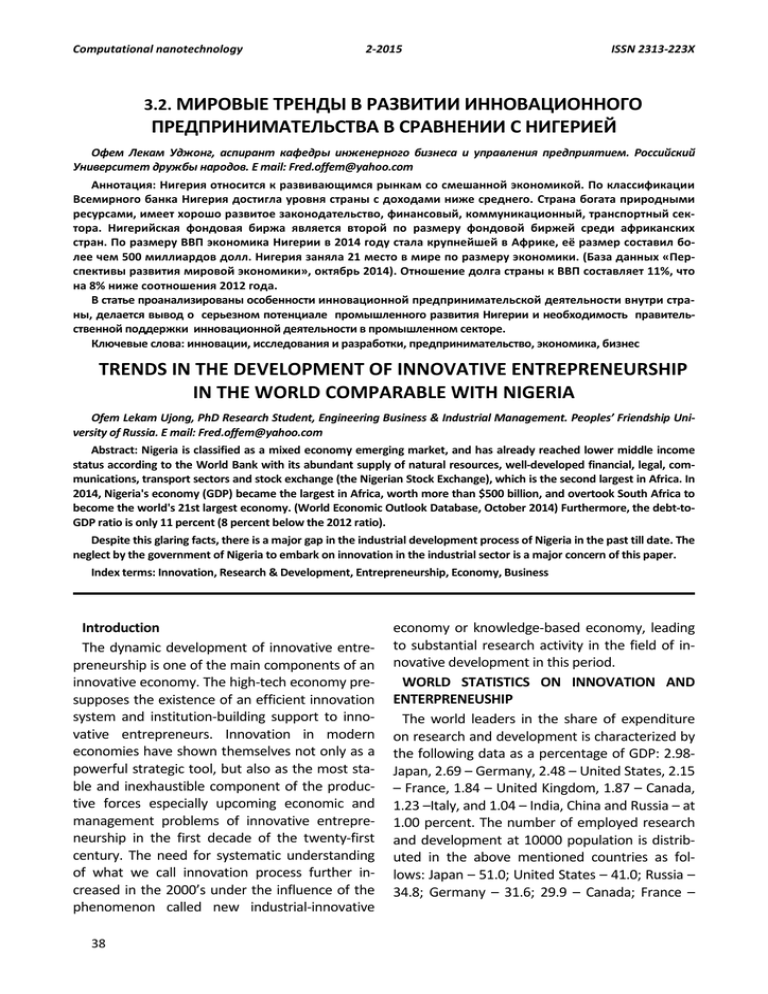
Computational nanotechnology 2-2015 ISSN 2313-223X 3.2. МИРОВЫЕ ТРЕНДЫ В РАЗВИТИИ ИННОВАЦИОННОГО ПРЕДПРИНИМАТЕЛЬСТВА В СРАВНЕНИИ С НИГЕРИЕЙ Офем Лекам Уджонг, аспирант кафедры инженерного бизнеса и управления предприятием. Российский Университет дружбы народов. E mail: [email protected] Аннотация: Нигерия относится к развивающимся рынкам со смешанной экономикой. По классификации Всемирного банка Нигерия достигла уровня страны с доходами ниже среднего. Страна богата природными ресурсами, имеет хорошо развитое законодательство, финансовый, коммуникационный, транспортный сектора. Нигерийская фондовая биржа является второй по размеру фондовой биржей среди африканских стран. По размеру ВВП экономика Нигерии в 2014 году стала крупнейшей в Африке, её размер составил более чем 500 миллиардов долл. Нигерия заняла 21 место в мире по размеру экономики. (База данных «Перспективы развития мировой экономики», октябрь 2014). Отношение долга страны к ВВП составляет 11%, что на 8% ниже соотношения 2012 года. В статье проанализированы особенности инновационной предпринимательской деятельности внутри страны, делается вывод о серьезном потенциале промышленного развития Нигерии и необходимость правительственной поддержки инновационной деятельности в промышленном секторе. Ключевые слова: инновации, исследования и разработки, предпринимательство, экономика, бизнес TRENDS IN THE DEVELOPMENT OF INNOVATIVE ENTREPRENEURSHIP IN THE WORLD COMPARABLE WITH NIGERIA Ofem Lekam Ujong, PhD Research Student, Engineering Business & Industrial Management. Peoples’ Friendship University of Russia. E mail: [email protected] Abstract: Nigeria is classified as a mixed economy emerging market, and has already reached lower middle income status according to the World Bank with its abundant supply of natural resources, well-developed financial, legal, communications, transport sectors and stock exchange (the Nigerian Stock Exchange), which is the second largest in Africa. In 2014, Nigeria's economy (GDP) became the largest in Africa, worth more than $500 billion, and overtook South Africa to become the world's 21st largest economy. (World Economic Outlook Database, October 2014) Furthermore, the debt-toGDP ratio is only 11 percent (8 percent below the 2012 ratio). Despite this glaring facts, there is a major gap in the industrial development process of Nigeria in the past till date. The neglect by the government of Nigeria to embark on innovation in the industrial sector is a major concern of this paper. Index terms: Innovation, Research & Development, Entrepreneurship, Economy, Business Introduction The dynamic development of innovative entrepreneurship is one of the main components of an innovative economy. The high-tech economy presupposes the existence of an efficient innovation system and institution-building support to innovative entrepreneurs. Innovation in modern economies have shown themselves not only as a powerful strategic tool, but also as the most stable and inexhaustible component of the productive forces especially upcoming economic and management problems of innovative entrepreneurship in the first decade of the twenty-first century. The need for systematic understanding of what we call innovation process further increased in the 2000’s under the influence of the phenomenon called new industrial-innovative 38 economy or knowledge-based economy, leading to substantial research activity in the field of innovative development in this period. WORLD STATISTICS ON INNOVATION AND ENTERPRENEUSHIP The world leaders in the share of expenditure on research and development is characterized by the following data as a percentage of GDP: 2.98Japan, 2.69 – Germany, 2.48 – United States, 2.15 – France, 1.84 – United Kingdom, 1.87 – Canada, 1.23 –Italy, and 1.04 – India, China and Russia – at 1.00 percent. The number of employed research and development at 10000 population is distributed in the above mentioned countries as follows: Japan – 51.0; United States – 41.0; Russia – 34.8; Germany – 31.6; 29.9 – Canada; France – TRENDS IN THE DEVELOPMENT OF INNOVATIVE ENTREPRENEURSHIP IN THE WORLD COMPARABLE WITH NIGERIA Ofem Lekam Ujong 27,2; United Kingdom – 26.7; Italy – 11.3; China and India, respectively, – 5.5 and 1.6 persons. For Nigeria, according to statistics for the year 2013 these two characteristics of innovation activities amounted to 0.33% of GDP, and 10.1 percent at 10000 population that is lower than the 2012 percent. The production of innovative products in Nigeria amounted to 82597.4 billion. That is 0.48% of GDP. If you compare with 20121.19% from 2011 -0.69%, there is trend decline in product innovation. Cost of technological innovation in 2013 amounted to 61050.9 million or 0.36% of GDP (compared to 2011-0.65%, 2012-0.71%). The statistics shows most large domestic expenditures on research and development in Israel (4.28% of GDP), Finland (3.96%), and Japan (3.33%). However, if we consider Nigeria in comparison with other countries, the obvious is that the share of the costs of research and development in the country's GDP is very low and is 0.24%, but turning to the internal statistics of the country, there is a tremendous growth rate of 200% for this indicator which Nigeria has demonstrated during the period 2002-2014 years. Compared with China, the high growth rate of domestic research and development costs shows China at 124%. Table 1. Domestic expenditures on research and development 2002-2014 biennium. Share on Share on The growth At Million R & D to R & D to rate of R&D by PP GDP in GDP in B/W 20021999. % 2009. % 2014 In % Israel 8794,4 352, 4,28 21,6 Germany 83974,8 2,40 2,78 15,8 France 47953,5 2,16 2,21 2,31 Italy 24752,6 1,02 1,27 24,5 Finland 7555,0 3,96 3,96 24,9 Japan 148719,2 23,02 3,33 10,3 USA 398194,0 2,64 2,79 5,7 China 120613,5 0,76 1,70 123,7 Russia 33568,1 1,00 1,24 24 Turkey 8681,2 0,47 0,85 80,9 Mexico 5719,6 0,39 0,37 -5,1 Nigeria 6082,0 0,03 0,24 200 EU 299635 1,72 1,90 10,5 OECD 964414,1 2,16 2,33 7,9 Countries Source: OECD, Main Science and Technology Indicators database, February 2014, Agency for statistics, 2014. However, it should be noted in the past year, the positive trend of growth of expenditures on research and development in Nigeria in 20110.21% in 2012-0, 22%, in 2013-0.24% of GDP in the structural analysis of internal expenses for research and development funding in all countries mostly in business and Government. These sectors account for about 80% of all 90% financial investments. The most common structural difference of Nigeria from the developed countries is the predominance of public funding. In Nigeria, you can observe the trend of decline in the share of public sector in research and development at 28.3% in the year 2013, and there has been a sharp increase in the share of the private nonprofit sector with 1.1% in 2010, up to 9.2% in settle. At present in Nigeria, there are a number of problems related to personnel security in the sphere of science. There has been a longterm downward trend in the number of professionals employed in the field of scientific and technological development. This is due to the fact that this sector is not attractive for longterm career growth, in view of the characteristics of the local labour market in the scientific field which primarily reflected in low wages, have a negative effect not only on the number of science personnel, but also on their quality. In terms of the number of researchers who are active on research and development, Nigeria is very inferior to many foreign countries. For example, the United States on the given indicator is superior to Nigeria in 114 times, Japan at 58 times, Russia in 44 times, Germany at 24 times. In Nigeria there is a shortage of staff capable of managing innovation processes and projects. In general, despite some positive developments in the field of sciences, the staff of the sciences requires effective State support and stimulation. As we are aware, the development of the modern world is based on progress in science and technology and innovation. This process is characterized by great dynamism, speed changes, which are intensified by the growing 39 Computational nanotechnology 2-2015 globalization of the economic, political and socio-cultural life of different countries and regions, regardless of their level of development. Globalization in general was the result of a more open economic policy in a growing number of countries and significantly lower costs to transportation and communications. This has increased global competition and reduced product life cycles, forcing the company to accelerate the development of new products and services and introducing them in turn. Globalization makes knowledge more widely available with the rapid internationalization of innovation, research and development. This in turn affects the international cooperation in the field of research and development which is becoming more open and intense. Growing integration of various technologies, leading to an increase in the number of multidisciplinary technologies and knowledge also positively influenced both the process: internationalization of foreign direct investment (FDI) and innovations. The higher the need for cross-disciplinary international research, the less possibility of a private company. Complexity makes innovation more costly and more risky by encouraging companies to find partners with the necessary experience to get quick access to knowledge and technology. The cause of the internationalization of FDI is their low cost (for example, in developing countries). If innovation is the basis of prosperity and competitive advantage in today's world, the acceleration of innovation business-additional strengthening will be of competitive advantages. And all developed countries will take into account this factor and use it to strengthen their global position. Winner is the one who runs the innovations earlier than others. International cooperation in science, technology, and innovation extends the capabilities of the States participating in the process, thanks to the exchange of ideas, knowledge, financial, organizational and physical facilities, etc. 40 ISSN 2313-223X In developed countries, the developers of scientific and technology and innovation policies are giving increasing importance to those areas of Research & Development and innovative development that focus on the growth of the public welfare. The ongoing transformation of the economy of Nigeria and formation of a competitive system are radical transformation of the mixed economy which was proposed as the only way forward. The main value in enhancing the competitiveness of Nigeria is when technological transformation is overcoming technological degradation, mastering modern techniques of the fifth and sixth technological modes. For example, in Russia and in other countries at present, there is challenges of transition to an innovative type of economic development which is the industrial, and it is innovative in view of the fact that it has not fully developed the industrial sector but focuses on strategy to support high-tech manufacturing sector, (innovation) and entrepreneurship. The structural transformation of the economy of Nigeria has to cope with energy exportoriented sector, advance the development of the manufacturing sector, increased proportionality and balance of economic development on the basis of their sustainable growth based on modernization of production. In Nigeria SMEs are broadly defined as businesses with turnover of less than N100 MM per annum and/ or less than 300 employees. Studies by the IFC show that approx. 96% of Nigerian businesses are SMEs compared to 53% in the US and 65% in Europe. SMEs represent about 90% of the manufacturing/ industrial sector in terms of number of enterprises. They contribute approx. 1% of GDP compared to 40% in Asian countries and 50% in the US or Europe. In Nigeria, SMEs are distributed by clusters within regions. Let’s take a look at some countries and their SMEs turn-over. TRENDS IN THE DEVELOPMENT OF INNOVATIVE ENTREPRENEURSHIP IN THE WORLD COMPARABLE WITH NIGERIA Ofem Lekam Ujong Table 2. Manufactured Exports by SMEs in both Developed and Developing Economies in the World. ECONOMY YEAR Romania 2014 20132014 2013 2014 20132014 2013 2013 India USA Italy UK China Nigeria PERCENTAG E (%) OF DIFINATION OF AN SME SME MANUFACT URE EXPORT Annual turnover 37.6% 30m investment in 40% Plant &Machinery 500 employees 88% 250 employees 68% 50-500 75% 100 employees 20-300 employees 92% 19.15% Source: elaboration of SME database and Eurostat Input Output tables 2013/2014, Sources includes U.S. Export Fact Sheets prepared by ITA’s Office of Trade and Economic Analysis 2014, A Resource Guide for Doing Business in the People’s Republic of China 2013 and SMB Chamber of Commerce and the Ministry of Micro, Small and Medium Enterprises. The analysis shows that Nigeria has all the potentials to embark on innovation and become one of the most successful entrepreneur countries in the series of world leaders of innovation. In order to ensure a high rate of annual growth of innovative entrepreneurship in the market conditions, a special State policy is needed not only in innovation and science and technology, but also in the socio-economic sector of the Nigerian state. Список литературы: 1. http://www.bankpedia.org/index.php/en/126english/s/23362-small-and-medium-sized-enterprises-smes 2. Banji Oyelaran-Oyeyinka, B. (2012): “SMEs: Issues, Challenges and Prospects”. International Conference on Financial Systems Strategy 2020. United Nations, in Accessed 12/09/2012. 3. http://ec.europa.eu/enterprise/policies/sme /factsfigures-analysis/performance-review/files/ supportingdocuments/2014/annual-report-smes-2014_en.pdf 4. Kalchetty Eresi 2008. Management of Finance in Small Scale Industry. Allahabad: Vohra publishes and Distributions. 5. Lawal, W. A., and Ijaiya, M. A. (2007): “Small and Medium Scale Enterprises Access to Commercial Banks‟ Credits and their Contributions to GDP in Nigeria”. Asian Economic Review, Journal of the Indian Institute of Economics. Vol. 49(3), pp. 360-368 6. http://www.worldbank.org/en/country/nigeria РЕЦЕНЗИЯ на статью аспиранта Офема Лекама на тему «Trends in the development of innovative entrepreneurship in the world comparable with Nigeria» Офем Лекам, аспирант кафедры инженерного бизнеса и управления предприятием инженерного факультета Российского университета дружбы народов, разрабатывает в качестве своего диссертационного исследования проблемы, связанные с инновационными подходами к формированию малого бизнеса в Нигерии и управления им. Данная статья является отражением теоретического осмысления основных направлений развития инноваций в предпринимательской деятельности. Офем Лекам рассматривает экономическое развитие различных стран в мире, делая вывод о том, что достижение успехов в экономике возможно сегодня лишь в результате развития инноваций как в создании бизнеса, так и в управлении им. Малый бизнес наиболее открыт и приемлем для создания и внедрения инноваций. Одновременно автор указывает на риски в продвижении инноваций и необходимость государственных инвестиций в промышленное развитие, а также четкой государственной политики. Как отмечает автор, перед Нигерией, занимающей особое положение среди других стран африканского континента, стоят важные задачи по широкомасштабной индустриализации всей хозяйственной деятельности. Правительство страны отдает себе отчет в том, что должна быть разработана специальная программа, направленная на расширение исследовательской деятельности в стране и создании специальных научноисследовательских институтов. Работа Офема Лекама представляет собой анализ большого количества научной и публицистической литературы, а также статических данных, характеризующих отдельные черты инновационной предпринимательской деятельности как внутри страны, так и за рубежом. Работа структурирована, логична, выводы не вызывают сомнений. Статья Офема Лекама на тему «Trends in the development of innovative entrepreneurship in the world comparable with Nigeria» представляет собой законченное научное исследование, имеющее практическое значение для разработки государственной политики в Нигерии в области индустриализации, и рекомендуется для опубликования в печати. Науч. руководитель: зам. зав. кафедрой инженерного бизнеса и управления инженерного факультета РУДН к.с.н., доц., Иванова Т.Б. 41



